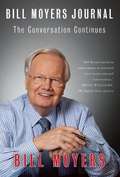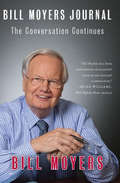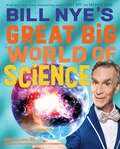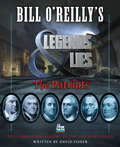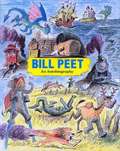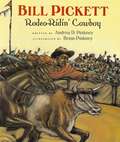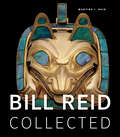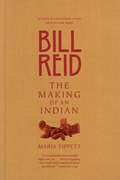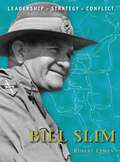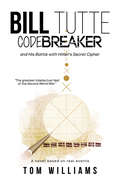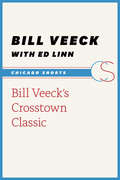- Table View
- List View
Bill Moyers Journal: The Conversation Continues
by Bill MoyersOne of the most highly rated public affairs programmes on American television, Bill Moyers' Journal drew up to two million weekly viewers from 2007 to 2010. With incisive, morally engaging text, this stunning companion brings Moyers' groundbreaking work to the page. Featuring extensive new commentary from Bill Moyers, it is an unparalleled guide to the debates, the cultural currents and above all the fascinating people that have so powerfully shaped today's world.
Bill Moyers Journal: The Conversation Continues
by Bill MoyersA companion volume to the Emmy Award–winning PBS® series—interviews with &“an essential voice in our national conversation&” (Brian Williams, MSNBC anchor). This &“provocative&” and &“absorbing&” (Star Tribune) companion book to Bill Moyer&’s acclaimed PBS series invites readers into conversations with some of the most captivating voices on the scene today, in what Kirkus Reviews calls &“a glittering array of discussions.&” From Jon Stewart on politics and media to Michael Pollan on food, The Wire creator David Simon on the mean streets of our cities, James Cone and Shelby Steele on race in the age of Obama, Robert Bly and Nikki Giovanni on the power of poetry, Barbara Ehrenreich on the hard times of working Americans, and Karen Armstrong on faith and compassion, Moyer&’s own intelligence and insight match that of his guests and their discussions animate many of the most salient issues of our time. With extensive commentary from Moyers, marked by his customary &“respect, intelligence, curiosity, humor, and graciousness,&” here are the debates; cultural currents; and, above all, lively minds that shape the conversation of democracy (Booklist). &“In an era of much instant and ephemeral talk, it is a pleasurable thing to hold this &‘book of ideas.&’&” —Publishers Weekly &“[Moyers] has always been about something beyond the moment. Or put another way, while everyone else in the media has been exploring topography, Moyers has been exploring geology.&” —Los Angeles Times
Bill Neal's Southern Cooking (Revised and Enlarged Edition)
by Bill NealSouthern cooking, the most interesting and complex regional cuisine in America, remains a mystery to many professional cooks and southerners. With a stellar collection of recipes, Neal reveals the background and subtleties of southern foods. He uses imaginative new ways with old standards to make the recipes more accessible, but he never resorts to shortcuts or processed ingredients. He also shows how the meeting of Native American, Western European, and African cultures has created this cuisine.
Bill Nye's Great Big World Of Science
by Bill Nye Gregory MoneScience educator, TV host, and New York Times-bestselling author Bill Nye is on a mission to help kids understand and appreciate the science that makes our world work. Featuring a range of subjects--physics, chemistry, geology, biology, astronomy, global warming, and more--this profusely illustrated book covers the basic principles of each science, key discoveries, recent revolutionary advances, and the problems that science still needs to solve for our Earth. Nye and coauthor Gregory Mone present the most difficult theories and facts in an easy-to-comprehend, humorous way. They interviewed numerous specialists from around the world, in each of the fields discussed, whose insights are included throughout. Also included are experiments kids can do themselves to bring science to life! Features photographs, illustrations, diagrams, glossary, bibliography, and index.
Bill Nye's Great Big World of Science
by Bill Nye Gregory MoneWith photos, experiments, and more, this “appealing and highly informative” science book from the beloved TV host is “a winner” (School Library Journal).Science educator, TV host, and New York Times–bestselling author Bill Nye is on a mission to help young people understand and appreciate the science that makes our world work. Featuring a range of subjects—physics, chemistry, geology, biology, astronomy, global warming, and more—this profusely illustrated book covers the basic principles of each science, key discoveries, recent revolutionary advances, and the problems that science still needs to solve for our Earth. Nye and coauthor Gregory Mone present the most difficult theories and facts in an easy-to-comprehend, humorous way. They interviewed numerous specialists from around the world, in each of the fields discussed, whose insights are included throughout. Also included are experiments kids can do themselves to bring science to life! “Wordplay and wry wit put extra fun into a trove of fundamental knowledge.” —Kirkus Reviews (starred review) Includes photographs, illustrations, diagrams, glossary, bibliography, and index
Bill O'Reilly's Legends and Lies: The Patriots (Bill O'Reilly's Legends and Lies)
by David Fisher<P>The must-have companion to Bill O'Reilly's historical docudrama Legends and Lies: The Patriots, an exciting and eye-opening look at the Revolutionary War through the lives of its leaders <P>The American Revolution was neither inevitable nor a unanimous cause. It pitted neighbors against each other, as loyalists and colonial rebels faced off for their lives and futures. These were the times that tried men's souls: no one was on stable ground and few could be trusted. <P>Through the fascinating tales of the first Americans, Legends and Lies: The Patriots reveals the contentious arguments that turned friends into foes and the country into a warzone. From the riots over a child's murder that led to the Boston Massacre to the suspicious return of Ben Franklin, the "First American;" from the Continental Army's first victory under George Washington's leadership to the little known southern Guerilla campaign of "Swamp Fox" Francis Marion, and the celebration of America's first Christmas, The Patriots recreates the amazing combination of resourcefulness, perseverance, strategy, and luck that led to this country's creation. <P>Heavily illustrated with spectacular artwork that brings this important history to vivid life, and told in the same fast-paced, immersive narrative as the first Legends and Lies, The Patriots is an irresistible, adventure-packed journey back into one of the most storied moments of our nation's rich history. <P><b>A New York Times Bestseller</b>
Bill O'Reilly's Legends and Lies: The Real West
by David Fisher Bill O'ReillyThe must-have companion to Bill O'Reilly's historic series Legends and Lies: The Real West, a fascinating, eye-opening look at the truth behind the western legends we all think we know<P><P> How did Davy Crockett save President Jackson's life only to end up dying at the Alamo? Was the Lone Ranger based on a real lawman-and was he an African American? What amazing detective work led to the capture of Black Bart, the "gentleman bandit" and one of the west's most famous stagecoach robbers? Did Butch Cassidy and the Sundance Kid really die in a hail of bullets in South America? Generations of Americans have grown up on TV shows, movies and books about these western icons. But what really happened in the Wild West? All the stories you think you know, and others that will astonish you, are here--some heroic, some brutal and bloody, all riveting. Included are the legends featured in Bill O'Reilly's ten week run of historic episodic specials-from Kit Carson to Jesse James, Wild Bill Hickok to Doc Holliday-- accompanied by two bonus chapters on Daniel Boone and Buffalo Bill and Annie Oakley.<P> Frontier America was a place where instinct mattered more than education, and courage was necessary for survival. It was a place where luck made a difference and legends were made. Heavily illustrated with spectacular artwork that further brings this history to life, and told in fast-paced, immersive narrative, Legends and Lies is an irresistible, adventure-packed ride back into one of the most storied era of our nation's rich history.
Bill O'Reilly's Legends and Lies: The Real West (Bill O'reilly's Legends And Lies Ser.)
by David Fisher Bill O'ReillyThe must-have companion to Bill O'Reilly's historic series Legends and Lies: The Real West, a fascinating, eye-opening look at the truth behind the western legends we all think we knowHow did Davy Crockett save President Jackson's life only to end up dying at the Alamo? Was the Lone Ranger based on a real lawman-and was he an African American? What amazing detective work led to the capture of Black Bart, the "gentleman bandit" and one of the west's most famous stagecoach robbers? Did Butch Cassidy and the Sundance Kid really die in a hail of bullets in South America? Generations of Americans have grown up on TV shows, movies and books about these western icons. But what really happened in the Wild West? All the stories you think you know, and others that will astonish you, are here--some heroic, some brutal and bloody, all riveting. Included are the ten legends featured in Bill O'Reilly's Legends and Lies docuseries -from Kit Carson to Jesse James, Wild Bill Hickok to Doc Holliday-- accompanied by two bonus chapters on Daniel Boone and Buffalo Bill and Annie Oakley.Frontier America was a place where instinct mattered more than education, and courage was necessary for survival. It was a place where luck made a difference and legends were made. Heavily illustrated with spectacular artwork that further brings this history to life, and told in fast-paced, immersive narrative, Legends and Lies is an irresistible, adventure-packed ride back into one of the most storied era of our nation's rich history.
Bill Peet: An Autobiography
by Bill PeetBill Peet tells his life story, including his years with Disney.
Bill Pickett: African-American Rodeo Cowboy (Legendary Heroes of the Wild West)
by Carl R. Green William R. SanfordBrings the action of the frontier days to life for the reluctant reader. Recounts the adventures of the explorers, pioneers, and settlers of the West.
Bill Pickett: Rodeo-ridin' Cowboy
by Andrea Davis Pinkney Brian PinkneyThe true sweat-and-dirt tale of the feisty cowboy-child who became the most famous black rodeo performer who ever lived. Includes a note about the history of the black West and a bibliography.
Bill Ratliff: A Profile of Courage and Leadership in American Politics
by Robert Edward SterkenLt. Governor Bill Ratliff is an engineer, a widely respected senator, and according to Caroline Kennedy he is “an inspiration to all who serve in government, and to all Americans.” Senator Ratliff, nicknamed “Obi Wan Kenobi” by his colleagues, was a revered and much loved leader in Texas for more than a decade. He singularly wrote the Texas Robin-Hood school finance law, a major Ethics reform law, a Texas tort reform law, and held a great disdain for narrow partisanship and politics. This is the inspirational story of a great man doing good work in a time when many are cynical about political leadership and government. His courageous stand on principle brought him to a showdown with powerful forces in the Bush White House and earned him the public vitriol of right-wing billionaires.
Bill Reid Collected
by Martine J. ReidOver his lifetime, Bill Reid created many historic pieces of art including the large bronze sculpture The Spirit of Haida Gwaii, nicknamed the Jade Canoe and displayed at the Vancouver International Airport, and The Raven and the First Men, a yellow cedar carving. Both are featured on the Canadian $20 bill. In addition to the immense praise for his artwork, Reid received the National Aboriginal Achievement Award for Lifetime Achievement in 1994. He continued to create stunning sculptures up until his death in 1998.Bill Reid Collected features the largest chronological collection of memorable works of Reid's career in full-color photographs and images to date. Along with an introductory essay by Dr. Martine J. Reid, this collection pays tribute to one of Canada's most renowned First Nations artists.
Bill Reid: The Making of an Indian
by Maria TippettPart biography, part art history -- a thoroughly engaging look at one man's life and his phenomenal influence on the world of contemporary art.Bill Reid was at the forefront of the modern-day renaissance of Northwest Coast Native art; but his art, and his life, was not without controversy. Like the raven -- the trickster and principal figure in countless Haida myths -- Bill Reid reinvented himself several times over. Born to a partly Haida mother and a father of German and Scottish descent, his public persona as a Haida Indian seems to have been as much a product of journalists, art patrons, museum curators and others in the non-Native establishment as of Bill Reid himself. It is clear that Reid's art arose from the tension that existed between his Native and white artistic perceptions.Award-winning biographer and cultural historian Maria Tippett became intrigued by this enigmatic figure who referred to his own early works as "artefakes," yet to this day continues to inspire new generations of Northwest Coast artists, including Robert Davidson and Jim Hart. But she questions whether Reid's status as the architect of contemporary Native art is fair and accurate, given that artists such as Mungo Martin had been keeping the tradition alive since the beginning of the twentieth century. Most controversially, she explores how Reid brought a sensibility formed through his white heritage to the reinvention of Native art.By asking difficult questions about Reid's life and work, and by analyzing the works of other Native artists since the beginning of the twentieth century, Tippet gives the reader the defining portrait of Bill Reid -- one of Canada's most enigmatic and beloved artists. Bill Reid's work can be found in private and public art galleries and museums all over the world. The Museum of Anthropology at the University of British Columbia houses the famous The Raven and The First Men and many smaller masterworks. The Spirit of Haida Gwaii, a monumental bronze sculpture over four metres high, is on display at the Canadian Embassy in Washington, D.C. The British Museum, the Musée de l'Homme in Paris and the Canadian Museum of Civilization in Ottawa also hold impressive examples of the work of this extraordinary and imaginative artist.
Bill Riley on the Air and at the Iowa State Fair
by Heather Torpy Bill Riley Sr.Many know Bill Riley as Mr. Iowa State Fair, the voice of the Drake Relays or the force behind the Bill Riley Talent Search. He wore all of those hats, along with countless more. An Iowan through and through, Bill worked tirelessly on behalf of the state's outdoor spaces and young people, raising money for bike trails and the Des Moines Children's Zoo, later known as the Blank Park Zoo. In the last years of his life, he collected these memories from a career stretching back to the debut of television in the Hawkeye State.
Bill Shankly: The Biography
by Stephen F Kelly'Football is not just a matter of life and death: it's much more important than that' - Bill ShanklyBill Shankly was without doubt among the greatest football managers of the post-war era and his life story is an inspiring read for anyone interested in the sport. To football fans everywhere, Bill Shankly was far more than just a manager: he was a folk hero whose legend still dominates the game.Shankly took Liverpool FC from Second Division obscurity and helped create the legend that became the Anfield of Keegan, Hughes, Toshack and Heighway. With his impertinent questions, blunt observations and appreciation of life, Bill Shankly's wit, down-to-earth wisdom and sheer determination set a standard that holds good to this day. This full and frank biography tells his larger-than-life story and is an inspiring tribute to one of football's most enduring heroes.
Bill Sherk Behind the Wheel 3-Book Bundle: 60 Years Behind the Wheel / I'll Never Forget My First Car / Old Car Detective
by Bill SherkThe rubber meets the road in Bill Sherk’s well-loved series of automotive books, a must-read for fans of classic and, er, “classic” cars. Includes 60 Years Behind the Wheel: From rumble seats and running broads to power tops and tailfins, Bill Sherk captures the thrill of motoring in Canada from the dawn of the twentieth century to 1960. Old Car Detective: Canada’s very own "Old Car Detective" Bill Sherk presents 80 of his favourite stories from all 10 provinces, spanning the years from 1925 to 1965. I’ll Never Forget My First Car: Bill Sherk describes in vivid detail the trials and tribulations of those brave souls who threw caution to the wind and money down the drain: They went out and bought their very first cars.
Bill Slim
by Peter Dennis Robert Lyman'Bill' Slim was one of the greatest British generals of World War II. In a career that stretched from 1914 until 1958 Bill Slim's greatest triumphs came in India and Burma in the long war against the Japanese between 1944 and 1945. This new Command title will cover both expeditions extensively. It also explores the legacy of a general that time often forgets. His success in rebuilding the morale and self-confidence of a defeated army remains at the heart of the way the British Army continues to train its soldiers today. He was no theoretical soldier, but in his demonstration of the principles of what is today called 'manoeuvre warfare' he is regarded as one of the finest commanders of the modern age and this book will help illustrate why.From the Trade Paperback edition.
Bill Stern’s Favorite Baseball Stories
by Bill SternAT BAT—WITH BILL STERNBaseball is a game rooted deep in the heart of America. I’ve loved it ever since I was a kid old enough to yell: “Take Me Out to the Ball Game!”As long as I can remember, I’ve been hearing stories of baseball...fascinating tales of fabulous heroes from a land where the sun always shines and men never grow old...curious legends that grew stranger with age...yarns that have been handed down with the years as treasured lore.As I grew older, and fate cast me in the rôle of a radio sports reporter and storyteller, I’ve been fortunate to meet many of the heroes, old and new—Babe Ruth, Lou Gehrig, Ty Cobb, Walter Johnson, Connie Mack, Grover Cleveland Alexander, Tris Speaker, Leo Durocher, Ted Williams, Bobby Feller and Joe DiMaggio, to name but a handful who have paraded before my microphone. And each in his way has enriched my collection of diamond stories.Of the countless stories I’ve heard from baseball men, I’ve treasured a number to hold, keep and remember.However, a storyteller who has been sharing his most interesting stories with millions of people finds it difficult to be miserly. Hence, I’ve chosen my favorites and offer them in print to all my fans for a generous dose of the romance, the glamour, the color, the thrills, the drama, the comedy, and the nostalgia that are all part of this game called baseball.Maybe I’ll score with some and get shut out on others but here they are just as I treasure them in my sports memory book—my favorite baseball stories.
Bill Tutte Codebreaker: and His Battle with Hitler’s Secret Cipher
by Tom WilliamsBILL TUTTE CODEBREAKER 'THE GREATEST INTELLECTUAL FEAT OF THE SECOND WORLD WAR.' … a testimonial to Bill Tutte and his codebreaking discovery in 1942 at Bletchley Park. Bill Tutte was a young, gauche PhD student, yet his remarkable breakthrough and continuing endeavour against a German cipher machine more complex than Enigma led to the development of the world's first programmable computer, Colossus. Colossus allowed top-secret messages between Hitler and his generals to be read within hours, contributing significantly to the success of the D-Day landings and the eventual defeat of Nazi Germany. So secret were the functions performed by Colossus that the work of Bill Tutte and his colleagues was classified for more than 50 years after the end of the Second World War. This novel not only explores Bill Tutte's codebreaking, but also examines his 'autistic' character, his background and close relationships all woven into the pressures and diversions of life at Bletchley Park. Prime Minister David Cameron wrote in 2012: We should never forget how lucky we were to have men like William 'Bill' Tutte in our darkest hour and the extent to which their work not only helped protect Britain itself but also shorten the war by an estimated two years, saving countless lives. … I can say without doubt that Bill Tutte deserves the thanks of the British people.
Bill Veeck's Crosstown Classic
by Ed Linn Bill VeeckBaseball Hall of Famer Bill Veeck (1914-86) was an inspired team builder, a consummate showman, and one of the greatest baseball men ever involved in the game. Bill Veeck's Crosstown Classic, drawn from his uproarious autobiography (cowritten with the talented sportswriter Ed Linn), is an unforgettable trip packed with anecdotes and insight about the history of baseball and tales of players and owners-some of the most entertaining stories in all of sports literature. Veeck's own love for the game began when his father was manager and then President of the Chicago Cubs; upon his father's death in 1930, Veeck was hired as an office boy for eighteen dollars a week. Here, Veeck recollects those halcyon days and how they underscored his development as a wily franchise owner, leading up to quite a rumpus, many years later, during his purchase of the White Sox from the "Battling Comiskeys. "
Bill W My First 40 Years: An Autobiography by the Co-founder of AA
by AnonymousTold here for the first time in his own words is the story Bill W.--a man who, for his part in founding Alcoholics Anonymous, would be honored as one of the most important figures of the 20th century."I was born, to be exact, in a hotel then known as Wilson House... I was born, perhaps rightly, in a room just back of the old bar." It was the beginning of a life that would change the lives of millions. Told here for the first time in his own words is the story of the man who would come to be known as Bill W. - a man who, for his part in founding the fellowship of Alcoholics Anonymous, would be celebrated as one of the important figures of the twentieth century."The terrifying darkness had become complete. In agony of spirit, I again thought of the cancer of alcoholism which had now consumed me in mind and spirit, and soon the body." But what of the Great Physician? For a brief moment, I suppose, the last trace of my obstinacy was crushed out as the abyss yawned.I remember saying to myself, "I'll do anything, anything at all. If there be a Great Physician, I'll call on him." Then, with neither faith nor hope I cried out, "If there be a God, let him show himself."
Bill W: The absorbing and deeply moving life story of Bill Wilson, co-founder of Alcoholics Anonymous
by Robert ThomsenRobert Thomsen's biography describes the story of Bill W., a stirring spiritual odyssey through triumph, failure, and rebirth, with vital meaning for men and women everywhere.This is the story of a man whose discovery and vision have changed the lives of millions of people throughout the world. Robert Thomsen's biography takes readers through the events of Bill W.'s life, all the while detailing Bill's growing dependence on alcohol. Thomsen writes of the collapse that brought Bill to the verge of death and of the luminous instant of insight that saved him. This turning point led Bill to the encounter in 1935 with Dr. Bob and the start of what was to be a new beginning for countless others who despaired of finding rescue and redemption. Every night at Alcoholics Anonymous meetings around the world, a speaker says, "Our stories disclose in a general way what we used to be like, what happened, and what we are like now." This describes the story of Bill W., a stirring spiritual odyssey through triumph, failure, and rebirth, with vital meaning for men and women everywhere.
Bill Wennington's Tales From the Bulls Hardwood
by Bill WenningtonChicago Bulls fans thought they had it so good. From 1991 through 1993 the Bulls won three consecutive NBA titles behind the talents of Michael Jordan and Scottie Pippen. When Jordan retired in the fall of 1993, those fans thought the good times were over. In the fall of 1995, however, Jordan was ready to make a full return to NBA action, Pippen was still the best number two man in basketball, and then bad-boy Dennis Rodman was signed to join the franchise that had grown to hate him. Suddenly, the Bulls had the greatest team in NBA history. Bill Wennington's Tales from the Bulls Hardwood tells some of the inside stories from that team, the one that won three more NBA titles from 1996 through 1998. Seen from the eyes of three-time NBA champion center Bill Wennington, the Bulls come to life differently, from an insider's point of view. The 1995-96 Bulls won an NBA record 72 games and became the Beatles of professional sports. Followed everywhere and talked about endlessly, they captured a national and international audience and kept all eyes upon them for three seasons, even though everyone knew they were going to win. Fans will read about some of the most famous names in basketball history. Jordan, the demanding team leader; Pippen, the true teammate; Rodman, the reckless rebounder; Toni Kukoc, the outsider; Ron Harper, the former star turned role player; Luc Longley, the affable Aussie; Steve Kerr, the John Paxson sequel; all playing for Phil Jackson, the Zen master coach. These are stories fans have not heard before, but it's not their fault. They just weren't there the way Bill Wennington was.
Bill Wilson: Changing the World
by Robert Simons Max SafferThis case describes the life choices of Bill Wilson, the founder of Alcoholics Anonymous. A young man with tremendous potential, Wilson hit rock bottom as a drunk. An epiphany, coupled with his personal drive, led him to build a worldwide organization that has helped millions of people recover from alcohol addiction. Students will learn how he navigated life's choices to leave a lasting impact on the world.
